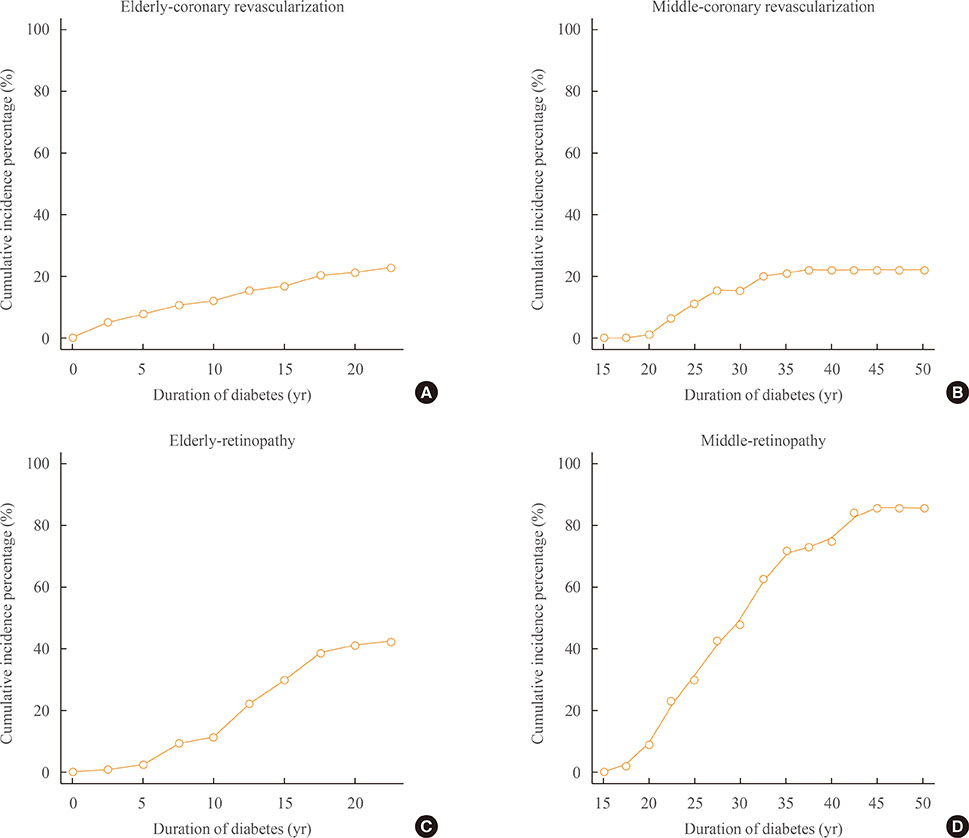Endocrinol Metab.
2016 Sep;31(3):416-423. 10.3803/EnM.2016.31.3.416.
Comparison of Age of Onset and Frequency of Diabetic Complications in the Very Elderly Patients with Type 2 Diabetes
- Affiliations
-
- 1Department of Internal Medicine, Kangwon National University School of Medicine, Chuncheon, Korea. ehcho@kangwon.ac.kr
- KMID: 2352981
- DOI: http://doi.org/10.3803/EnM.2016.31.3.416
Abstract
- BACKGROUND
The prevalence of type 2 diabetes in elderly people has increased dramatically in the last few decades. This study was designed to clarify the clinical characteristics of type 2 diabetes in patients aged ≥80 years according to age of onset.
METHODS
We reviewed the medical records of 289 patients aged ≥80 years with type 2 diabetes at the outpatient diabetes clinics of Kangwon National University Hospital from September 2010 to June 2014. We divided the patients into middle-age-onset diabetes (onset before 65 years of age) and elderly-onset diabetes (onset at 65+ years of age).
RESULTS
There were 141 male and 148 female patients. The patients had a mean age of 83.2±2.9 years and the mean duration of diabetes was 14.3±10.4 years. One hundred and ninety-nine patients had elderly-onset diabetes. The patients with elderly-onset diabetes had a significantly lower frequency of diabetic retinopathy and nephropathy, lower serum creatinine levels, lower glycated hemoglobin (HbA1c) levels, and similar coronary revascularization and cerebral infarction rates compared to those with middle-age-onset diabetes. There was no frequency difference in coronary revascularization and cerebral infarction and HbA1c levels between three subgroups (<5, 5 to 15, and ≥15 years) of diabetes duration in elderly onset diabetes. However, both in the elderly onset diabetes and middle-age-onset diabetes, the cumulative incidence of retinopathy was increasing rapidly according to the duration of diabetes.
CONCLUSION
We report that individuals with elderly-onset diabetes have a lower frequency of diabetic retinopathy and nephropathy and similar cardiovascular complications compared to those with middle-age-onset diabetes.
Keyword
MeSH Terms
Figure
Reference
-
1. Sloan FA, Bethel MA, Ruiz D Jr, Shea AM, Feinglos MN. The growing burden of diabetes mellitus in the US elderly population. Arch Intern Med. 2008; 168:192–199.2. Wilson PW, Anderson KM, Kannel WB. Epidemiology of diabetes mellitus in the elderly. The Framingham Study. Am J Med. 1986; 80:3–9.3. Jeon JY, Ko SH, Kwon HS, Kim NH, Kim JH, Kim CS, et al. Prevalence of diabetes and prediabetes according to fasting plasma glucose and HbA1c. Diabetes Metab J. 2013; 37:349–357.4. Wild S, Roglic G, Green A, Sicree R, King H. Global prevalence of diabetes: estimates for the year 2000 and projections for 2030. Diabetes Care. 2004; 27:1047–1053.5. Vacante M, Malaguarnera M, Motta M. Revision of the ADA-classification of diabetes mellitus type 2 (DMT2): the importance of maturity onset diabetes (MOD), and senile diabetes (DS). Arch Gerontol Geriatr. 2011; 53:113–119.6. Selvin E, Coresh J, Brancati FL. The burden and treatment of diabetes in elderly individuals in the U.S. Diabetes Care. 2006; 29:2415–2419.7. Wang Y, Qin MZ, Liu Q, Liu Q, Chang ZW. Clinical analysis of elderly patients with elderly-onset type 2 diabetes mellitus in China: assessment of appropriate therapy. J Int Med Res. 2010; 38:1134–1141.8. Malaguarnera M, Vacante M, Frazzetto PM, Motta M. The role of diabetes and aging in the determinism of hypertension and the related cerebrovascular complications. Arch Gerontol Geriatr. 2012; 55:221–225.9. Motta M, Bennati E, Capri M, Ferlito L, Malaguarnera M. Diabetes mellitus in the extreme longevity. Exp Gerontol. 2008; 43:102–105.10. Brown AF, Mangione CM, Saliba D, Sarkisian CA. California Healthcare Foundation/American Geriatrics Society Panel on Improving Care for Elders with Diabetes. Guidelines for improving the care of the older person with diabetes mellitus. J Am Geriatr Soc. 2003; 51:5 Suppl Guidelines. S265–S280.11. Kirkman MS, Briscoe VJ, Clark N, Florez H, Haas LB, Halter JB, et al. Diabetes in older adults: a consensus report. J Am Geriatr Soc. 2012; 60:2342–2356.12. Meneilly GS, Tessier D. Diabetes in elderly adults. J Gerontol A Biol Sci Med Sci. 2001; 56:M5–M13.13. Motta M, Bennati E, Cardillo E, Ferlito L, Malaguarnera M. Pathogenesis of senile diabetes. Indian J Med Res. 2008; 128:225–227.14. Morley JE, Mooradian AD, Rosenthal MJ, Kaiser FE. Diabetes mellitus in elderly patients. Is it different? Am J Med. 1987; 83:533–544.15. Andres R, Tobin JD. Aging and the disposition of glucose. Adv Exp Med Biol. 1975; 61:239–249.16. Andres R. Aging, diabetes, and obesity: standards of normality. Mt Sinai J Med. 1981; 48:489–495.17. Shimokata H, Muller DC, Fleg JL, Sorkin J, Ziemba AW, Andres R. Age as independent determinant of glucose tolerance. Diabetes. 1991; 40:44–51.18. Kim KS, Kim SK, Sung KM, Cho YW, Park SW. Management of type 2 diabetes mellitus in older adults. Diabetes Metab J. 2012; 36:336–344.
- Full Text Links
- Actions
-
Cited
- CITED
-
- Close
- Share
- Similar articles
-
- Response: Comparison of Age of Onset and Frequency of Diabetic Complications in the Very Elderly Patients with Type 2 Diabetes (Endocrinol Metab 2016;31:416-23, Bong-Ki Lee et al.)
- Letter: Comparison of Age of Onset and Frequency of Diabetic Complications in the Very Elderly Patients with Type 2 Diabetes (Endocrinol Metab 2016;31:416-23, Bong-Ki Lee et al.)
- Management of Diabetes in the Elderly
- Drug Therapy of Elderly Diabetic Patients
- Risk Factors for Early Development of Macrovascular Complications in Korean Type 2 Diabetes


